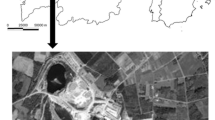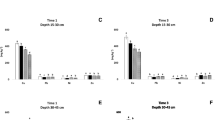Abstract
The soils at a depleted copper mine in Touro (Galicia, Spain) are chemically degraded. In order to determine the effect of amendments and vegetation on the chemical characteristics of a mine soil and on the plant uptake of metals, a greenhouse experiment was carried out for 3 months. A settling pond soil was amended with different percentages of a compost and biochar mixture and vegetated with Brassica juncea L. The results showed that the untreated settling pond soil was polluted by Cu. Amendments and planting mustards decreased the pseudototal concentration of this metal, reduced the extreme soil acidity and increased the soil concentrations of C and TN. Both treatments also decreased the CaCl2-extractable Co, Cu and Ni concentrations. However, the amendments increased the pseudototal concentration of Zn in the soil, provided by the compost that was used. The results also showed that mustards extracted Ni efficiently from soils, suggesting that B. juncea L. is a good phytoextractor of Ni in mine soils.




Similar content being viewed by others
References
Adriano DC, Wenzel WW, Vangronsveld J, Bolan NS (2004) Role of assisted natural remediation in environmental cleanup. Geoderma 122:121–142. doi:10.1016/j.geoderma.2004.01.003
Amlinger F, Götz B, Dreher P et al (2003) Nitrogen in biowaste and yard waste compost: dynamics of mobilisation and availability—a review. Eur J Soil Biol 39:107–116. doi:10.1016/S1164-5563(03)00026-8
Asensio V, Vega FA, Singh BR, Covelo EF (2013a) Effects of tree vegetation and waste amendments on the fractionation of Cr, Cu, Ni, Pb and Zn in polluted mine soils. Sci Total Environ 443:446–453. doi:10.1016/j.scitotenv.2012.09.069
Asensio V, Vega FA, Andrade ML, Covelo EF (2013b) Tree vegetation and waste amendments to improve the physical condition of copper mine soils. Chemosphere 90:603–610. doi:10.1016/j.chemosphere.2012.08.050
Asensio V, Vega FA, Andrade ML, Covelo EF (2013c) Technosols made of wastes to improve physico-chemical characteristics of a copper mine soil. Pedosphere 23:1–9. doi:10.1016/S1002-0160(12)60074-5
Atkinson CJ, Fitzgerald JD, Hipps NA (2010) Potential mechanisms for achieving agricultural benefits from biochar application to temperate soils: a review. Plant Soil 337:1–18. doi:10.1007/s11104-010-0464-5
Beesley L, Moreno-Jiménez E, Gomez-Eyles JL et al (2011) A review of biochars’ potential role in the remediation, revegetation and restoration of contaminated soils. Environ Pollut 159:3269–3282. doi:10.1016/j.envpol.2011.07.023
Bendfeldt ES, Burger JA, Lee Daniels W, Daniels WL (2001) Quality of amended mine soils after sixteen years. Soil Sci Soc Am J 65:1736–1744. doi:10.2136/sssaj2001.1736
Biederman LA, Harpole WS (2013) Biochar and its effects on plant productivity and nutrient cycling: a meta-analysis. GCB Bioenergy 5:202–214. doi:10.1111/gcbb.12037
Blackwell P, Reithmuller G, Collins M (2009) Biochar application to soil. In: Lehmann J, Joseph S (eds) Biochar Environ Manag Sci Technol. Earthscan, London, pp 207-226
Bolan N, Adriano D, Mahimairaja S (2004) Distribution and bioavailability of trace elements in livestock and poultry manure by-products. Crit Rev Environ Sci Technol 34:291–338. doi:10.1080/10643380490434128
Brown SL, Henry CL, Chaney R et al (2003) Using municipal biosolids in combination with other residuals to restore metal-contaminated mining areas. Plant Soil 249:203–215
Busuioc G, Elekes CC, Stihi C et al (2011) The bioaccumulation and translocation of Fe, Zn, and Cu in species of mushrooms from Russula genus. Environ Sci Pollut Res Int 18:890–896. doi:10.1007/s11356-011-0446-z
Chintala R, Mollinedo J, Schumacher TE et al (2014) Effect of biochar on chemical properties of acidic soil. Arch Agron Soil Sci 60:393–404. doi:10.1080/03650340.2013.789870
Chodak M, Niklińska M (2010) Effect of texture and tree species on microbial properties of mine soils. Appl Soil Ecol 46:268–275. doi:10.1016/j.apsoil.2010.08.002
Clemente R, Almela C, Bernal MP (2006) A remediation strategy based on active phytoremediation followed by natural attenuation in a soil contaminated by pyrite waste. Environ Pollut 143:397–406. doi:10.1016/j.envpol.2005.12.011
Conesa HM, Schulin R (2010) The Cartagena-La Unión mining district (SE Spain): a review of environmental problems and emerging phytoremediation solutions after fifteen years research. J Environ Monit 12:1225–1233. doi:10.1039/c000346h
Conesa HM, Faz A, Arnaldos R (2007a) Initial studies for the phytostabilization of a mine tailing from the Cartagena-La Union Mining District (SE Spain). Chemosphere 66:38–44. doi:10.1016/j.chemosphere.2006.05.041
Conesa HM, Faz Á, García G, Arnaldos R (2007b) Heavy metal contamination in the semiarid area of Cartagena-La Unión (SE Spain) and its implications for revegetation. Fresenius Environ Bull 16:1076–1081
D’Emilio M, Caggiano R, Macchiato M et al (2013) Soil heavy metal contamination in an industrial area: analysis of the data collected during a decade. Environ Monit Assess 185:5951–5964. doi:10.1007/s10661-012-2997-y
De Varennes A, Abreu MM, Qu G, Cunha-Queda C (2010) Enzymatic activity of a mine soil varies according to vegetation cover and level of compost applied. Int J Phytoremediation 12:371–383. doi:10.1080/15226510903051757
Do Nascimento CW, Amarasiriwardena D, Xing B (2006) Comparison of natural organic acids and synthetic chelates at enhancing phytoextraction of metals from a multi-metal contaminated soil. Environ Pollut 140:114–123. doi:10.1016/j.envpol.2005.06.017
Evangelou MWH, Daghan H, Schaeffer A (2004) The influence of humic acids on the phytoextraction of cadmium from soil. Chemosphere 57:207–213. doi:10.1016/j.chemosphere.2004.06.017
Fellet G, Marmiroli M, Marchiol L (2014) Elements uptake by metal accumulator species grown on mine tailings amended with three types of biochar. Sci Total Environ 468-469C:598–608. doi:10.1016/j.scitotenv.2013.08.072
Fowles M (2007) Black carbon sequestration as an alternative to bioenergy. Biomass Bioenergy 31:426–432. doi:10.1016/j.biombioe.2007.01.012
Hemmat A, Aghilinategh N, Rezainejad Y, Sadeghi M (2010) Long-term impacts of municipal solid waste compost, sewage sludge and farmyard manure application on organic carbon, bulk density and consistency limits of a calcareous soil in central Iran. Soil Tillage Res 108:43–50. doi:10.1016/j.still.2010.03.007
Houba VJG, Temminghoff EJM, Gaikhorst GA, Van Vark W (2000) Soil analysis procedures using 0.01 M calcium chloride as extraction reagent. Commun Soil Sci Plant Anal 31:1299–1396
Karami N, Clemente R, Moreno-Jiménez E et al (2011) Efficiency of green waste compost and biochar soil amendments for reducing lead and copper mobility and uptake to ryegrass. J Hazard Mater 191:41–48. doi:10.1016/j.jhazmat.2011.04.025
Laird D, Brown R (2009) Review of the pyrolysis platform for coproducing bio‐oil and biochar. Biofuels Bioprod Bioref 3:547–562. doi:10.1002/bbb
Lehmann J (2007) A handful of carbon. Nature 447:10–11
Lehmann J, Joseph S (2009) Biochar for environmental management: an introduction. In: Lehmann J, Joseph S (eds) Biochar Environ. Manag. Sci. Technol. Earthscan, London, pp 1–12
Lombi E, Zhao FJ, Dunham SJ, McGrath SP (1999) Phytoremediation of heavy metal-contaminated soils: natural hyperaccumulation versus chemically enhanced phytoextraction. J Environ Qual 30:1919–1926
Lottermoser BG, Ashley PM, Munksgaard NC (2008) Biogeochemistry of Pb-Zn gossans, northwest Queensland, Australia: implications for mineral exploration and mine site rehabilitation. Appl Geochem 23:723–742. doi:10.1016/j.apgeochem.2007.12.001
Macías F, Calvo de Anta R (2009) Niveles genéricos de referencia de metales pesados y otros elementos traza en los suelos de Galicia. Xunta de Galicia, Spain
Mench M, Lepp N, Bert V et al (2010) Successes and limitations of phytotechnologies at field scale: outcomes, assessment and outlook from COST Action 859. J Soils Sediments 10:1039–1070. doi:10.1007/s11368-010-0190-x
Misra V, Tiwari A, Shukla B, Seth CS (2009) Effects of soil amendments on the bioavailability of heavy metals from zinc mine tailings. Environ Monit Assess 155:467–475. doi:10.1007/s10661-008-0449-5
Nouri J, Khorasani N, Lorestani B et al (2009) Accumulation of heavy metals in soil and uptake by plant species with phytoremediation potential. Environ Earth Sci 59:315–323. doi:10.1007/s12665-009-0028-2
Novak JM, Busscher WJ, Laird DL et al (2009) Impact of biochar amendment on fertility of a Southeastern Coastal Plain soil. Soil Sci 174:105–112. doi:10.1097/SS.0b013e3181981d9a
Novo LAB, Covelo EF, González L (2013a) The potential of Salvia verbenaca for phytoremediation of copper mine tailings amended with technosol and compost. Water Air Soil Pollut 224:1513. doi:10.1007/s11270-013-1513-5
Novo LAB, Covelo EF, González L (2013b) Phytoremediation of amended copper mine tailings with Brassica juncea. Int J Min Reclam Environ 27:215–226. doi:10.1080/17480930.2013.779061
Pardo T, Clemente R, Bernal MP (2011) Effects of compost, pig slurry and lime on trace element solubility and toxicity in two soils differently affected by mining activities. Chemosphere 84:642–650. doi:10.1016/j.chemosphere.2011.03.037
Park JH, Lamb D, Paneerselvam P et al (2011) Role of organic amendments on enhanced bioremediation of heavy metal (loid) contaminated soils. J Hazard Mater 185:549–574. doi:10.1016/j.jhazmat.2010.09.082
Peijnenburg WJG, Jager T (2003) Monitoring approaches to assess bioaccessibility and bioavailability of metals: matrix issues. Ecotoxicol Environ Saf 56:63–77. doi:10.1016/S0147-6513(03)00051-4
Pérez-Esteban J, Escolástico C, Masaguer A, Moliner A (2012) Effects of sheep and horse manure and pine bark amendments on metal distribution and chemical properties of contaminated mine soils. Eur J Soil Sci 63:733–742. doi:10.1111/j.1365-2389.2012.01468.x
Porta J (1986) Técnicas y experimentos en Edafología. Collegi Oficial D’Enginyers Agronoms de Catalunya, Barcelona
Puig CG, Álvarez-Iglesias L, Reigosa MJ, Pedrol N (2013) Eucalyptus globulus leaves incorporated as green manure for weed control in maize. Weed Sci 61:154–161. doi:10.1614/WS-D-12-00056.1
Purakayastha TJ, Viswanath T, Bhadraray S et al (2008) Phytoextraction of zinc, copper, nickel and lead from a contaminated soil by different species of Brassica. Int J Phytoremediation 10:61–72. doi:10.1080/15226510701827077
Quartacci MF, Argilla A, Baker AJM, Navari-Izzo F (2006) Phytoextraction of metals from a multiply contaminated soil by Indian mustard. Chemosphere 63:918–925. doi:10.1016/j.chemosphere.2005.09.051
Sæbø A, Ferrini F (2006) The use of compost in urban green areas—a review for practical application. Urban For Urban Green 4:159–169
Salt DE, Smith RD, Raskin I (1998) Phytoremediaton. Annu Rev Plant Physiol Plant Mol Biol 49:643–668
Shrestha RK, Lal R (2008) Land use impacts on physical properties of 28 years old reclaimed mine soils in Ohio. Plant Soil 306:249–260. doi:10.1007/s11104-008-9578-4
Shu WS, Ye ZH, Zhang ZQ et al (2005) Natural colonization of plants on five lead/zinc mine tailings in southern China. Restor Ecol 13:49–60. doi:10.1111/j.1526-100X.2005.00007.x
Singh SK, Ramprakash, Kumari S, Duhan BS (2013) Phytoextraction of Ni from contaminated soil by Brassica juncea as influenced by chelating agents. Ann Biol 29:15–18
Sneath HE, Hutchings TR, de Leij FAAM (2013) Assessment of biochar and iron filing amendments for the remediation of a metal, arsenic and phenanthrene co-contaminated spoil. Environ Pollut 178:361–366. doi:10.1016/j.envpol.2013.03.009
Sohi SP, Krull E, Lopez-Capel E, Bol R (2010) A review of biochar and its use and function in soil. Adv Agron 105:47–82. doi:10.1016/S0065-2113(10)05002-9
Solís-Dominguez FA, White SA, Hutter TB et al (2012) Response of key soil parameters during compost-assisted phytostabilization in extremely acidic tailings: effect of plant species. Environ Sci Technol 46:1019–1027. doi:10.1021/es202846n
Tordoff GM, Baker AJ, Willis AJ (2000) Current approaches to the revegetation and reclamation of metalliferous mine wastes. Chemosphere 41:219–228
USDA Natural Resources Conservation Service (USDA-NRCS) (1998) Soil quality indicators: pH. Soil quality information sheet
Vega FA, Covelo EF, Andrade ML (2005) Limiting factors for reforestation of mine spoils from Galicia (Spain). Land Degrad Dev 16:27–36. doi:10.1002/ldr.642
Wuest SB, Albrecht SL, Skirvin KW (2000) Crop residue position and interference with wheat seedling development. Soil Tillage Res 55:175–182. doi:10.1016/S0167-1987(00)00116-1
Yang S, Cao J, Hu W et al (2013) An evaluation of the effectiveness of novel industrial by-products and organic wastes on heavy metal immobilization in Pb-Zn mine tailings. Environ Sci Process Impacts 15:2059–2067. doi:10.1039/c3em00338h
Yin Chan K, Xu Z (2009) Biochar: nutrient properties and their enhancement. In: Lehmann J, Joseph S (eds) Biochar Environ Manag Sci Technol. Earthscan, London, pp 67-84
Acknowledgments
This study was supported by the Spanish Ministry of Education and Science through project CGL2009-07843 and by the University of Vigo through a pre-doctoral fellowship awarded to V. Asensio.
Author information
Authors and Affiliations
Corresponding author
Additional information
Responsible editor: Elena Maestri
Rights and permissions
About this article
Cite this article
Rodríguez-Vila, A., Covelo, E.F., Forján, R. et al. Phytoremediating a copper mine soil with Brassica juncea L., compost and biochar. Environ Sci Pollut Res 21, 11293–11304 (2014). https://doi.org/10.1007/s11356-014-2993-6
Received:
Accepted:
Published:
Issue Date:
DOI: https://doi.org/10.1007/s11356-014-2993-6




